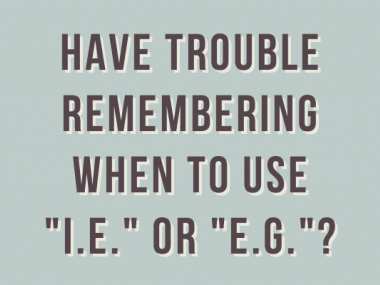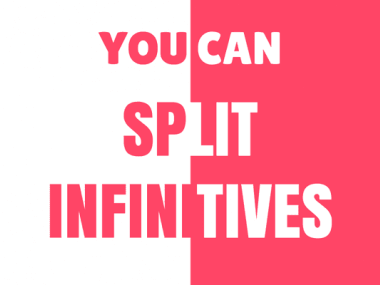‘Bad’ or ‘Badly’?
“I feel bad.” “I feel badly.” Which is it?
If you’re unhappy or sick, you feel bad, not badly. To feel badly would be to stink at feeling things. Rarely does anyone intend to convey that kind of ineptitude. Yet people pair “feel” with “badly” all the time. It’s not unusual to hear things like this:
- “The babysitter felt badly that the washing machine flooded the basement.”
- “Squiggly feels badly about the score of the big game.”
- “Aardvark is going to feel badly when no one shows up at the birthday party.”
In fact, in all these sentences, the subject felt, feels, or will feel not badly but bad. This is how to write these sentences correctly:
- “The babysitter felt bad that the washing machine flooded the basement.”
- “Squiggly feels bad about the score of the big game.”
- “Aardvark is going to feel bad when no one shows up at the birthday party.”
In short, say “feel bad,” not “feel badly.”
Why People Say ‘Feel Badly’
It’s understandable that people want to tack on the “ly.” “Feel” is a verb, after all, and people are often taught that verbs are modified by adverbs. “Badly,” with its telltale “ly” suffix, is conspicuously an adverb. So “feel” would seem to cry out for “badly.”
How can “bad”—an adjective—modify “feel,” you might wonder?
The Sentence Mechanics Behind ‘I Feel Bad’
As an adjective, “bad” can’t modify “feel.” An adjective has one job: to modify a noun. In fact, that’s exactly what “bad” does in the sentence “I feel bad.” It modifies the subject: “I.”
In the sentence “I feel bad,” “bad” is what’s called a subject complement. The subject (“I”) and its complement (“bad”) are grammatically linked, identified with each other like two sides of an equation. What links them, like an equal sign, is the verb “feel.”
In other words, “feel,” here, is what’s called a linking verb.
What’s so special about linking verbs? They are grammatical passthroughs. A linking verb, also known as a copula, may connect a modifier (like “bad”) to another word (like “I”).
So no, “feel”—as a linking verb—does not cry out for “badly.”
Wait, ‘Feel’ Is a Linking Verb?
You might not think of “feel” as a linking verb. In fact, the verb “feel” has a chameleon-like nature: It can function as either a linking verb or an action verb.
Typically, English students learn to recognize linking verbs by looking for “be”-verbs (“is,” “am,” “was,” “were,” “are,” “have been being,” and so on) for the excellent reason that “be”-verbs often act as linking verbs. Other verbs sometimes act as linking verbs, too (including “feel,” “grow” “appear,” “become,” “seem,” “look,” “prove,” “remain,” “smell,” “sound,” “taste,” “turn,” “stay,” and “get”).
Take “grow.” It’s a linking verb in “The turnips grow rancid.” It’s an action verb in “The turnips grow rapidly.”
Now let’s look at “feel” in a mix of roles:
- “The bricks feel smooth.” Here, “feel” is a linking verb because “smooth” describes the bricks.
- “The neighbors feel the earthquake.” Here, “feel” is an action verb because it’s what the neighbors are doing.
- “The concierge feels ecstatic.” Here, “feels” is a linking verb because “ecstatic” describes the concierge.
- “The horse feels its way along the path.” Here, “feels” is an action verb because it’s what the horse is doing.
How to Spot a Linking Verb: The Quick and Dirty Tip
How do you know whether a verb is acting as a linking verb? (That, it turns out, is the question behind this post’s question of whether to say “I feel bad” or “I feel badly.”)
If you’re not sure how to spot a linking verb, here’s a Quick and Dirty Tip: Swap in a “be”-verb. If the resulting statement works—which is to say, if you’re looking at a statement about the subject’s state—you have a linking verb on your hands. Don’t follow that verb with an adverb, such as “badly.” Ix-nay on the “ly” words. Stick with adjectives.
Here are some examples:
Example 1—“The turnips grow rancid.”
Think, “The turnips are rancid.” This works as a statement—however improbable—about the turnips’ state. So you know that, in this case, “grow” is a linking verb. Keep the adjective (“rancid”).
Example 2— “The turnips grow rapidly.”
Think, “The turnips are rapidly.” This statement makes no sense. So you know that, in this case, “grow” is not a linking verb. It’s an action verb. Keep the adverb (“rapidly”).
Example 3—“I feel bad.”
Think, “I am bad.” This works—not because we’re talking about a bad person but because “I am bad” is a statement about the subject’s state. So you know that, in this case, “feel” is a linking verb. Keep the adjective (“bad”).
Example 4—“I feel badly.”
Think, “I am badly.” This statement makes no sense. So you know that, in this case, “feel” is not a linking verb. It’s an action verb. Keep the adverb (“badly”) … if you want to alert people to, say, your underabundance of nerve endings—your inability to feel. Otherwise, if it’s your emotional or physical state you want to convey, use “feel” as linking verb. Lose the “ly.” Let the world know, with confidence, that you feel bad.
The Common Use of ‘Feel Badly’ for ‘Feel Bad’
Do people say “feel badly” for “feel bad” often enough that this phrase has become generally acceptable? Not so far—at least not in print—says grammarian and language enthusiast Bryan Garner, who tracks changes in English usage. He says that “most professional writers know this point of usage.” According to his research, in modern print sources, “feel bad” outnumbers “feel badly” by a 9:1 ratio (1), and “felt bad” outnumbers “felt badly” by a 6:1 ratio. (2)
Garner places both uses (“feel badly” for “feel bad” and “felt bad” for “felt badly”) at Stage 2 in his five-stage Language-Change Index, meaning that this usage has spread “to a significant fraction of the language community but remains unacceptable in standard usage.” (3)
What About ‘I Feel Well’?
As a final defense of “I feel badly,” you might point to the common use of the phrase “I feel well” to mean “I feel healthy.” Since “well” (usually an adverb) is widely accepted after “feel,” why not “badly”?
Consider these two points:
- While “feel well” is widely used, “feel good” works perfectly well to describe a state of health.
- If your reason for saying “feel well” is that “feel” requires an adverb, you’re hypercorrecting. “Feel” is a linking verb here. “Well” does not modify “feel.” “Well” is a complement of the subject, “I.” In this case, “well” functions as an adjective.
Maybe someday “feel badly” will become as widely accepted as “feel well,” but we’re not there yet.
Summary
In summary, learn to spot linking verbs by checking to see if you can swap in a “be”-verb, such as “is” or “am.” When in doubt, avoid following linking verbs with adverbs. For example, say “I feel bad,” not “I feel badly.” Otherwise, your word-savvy friends will feel unhappily.
That segment was written by Marcia Riefer Johnston, author of “Word Up! How to Write Powerful Sentences and Paragraphs (And Everything You Build From Them).” Marcia blogs at Writing.Rocks.
Image courtesy of Shutterstock.
References
-
Garner, Bryan A. Garner’s Modern English Usage, fourth edition. Oxford: Oxford University Press, 2016, p. 382.
Garner, p. 91.
Garner, p. xxxi.






